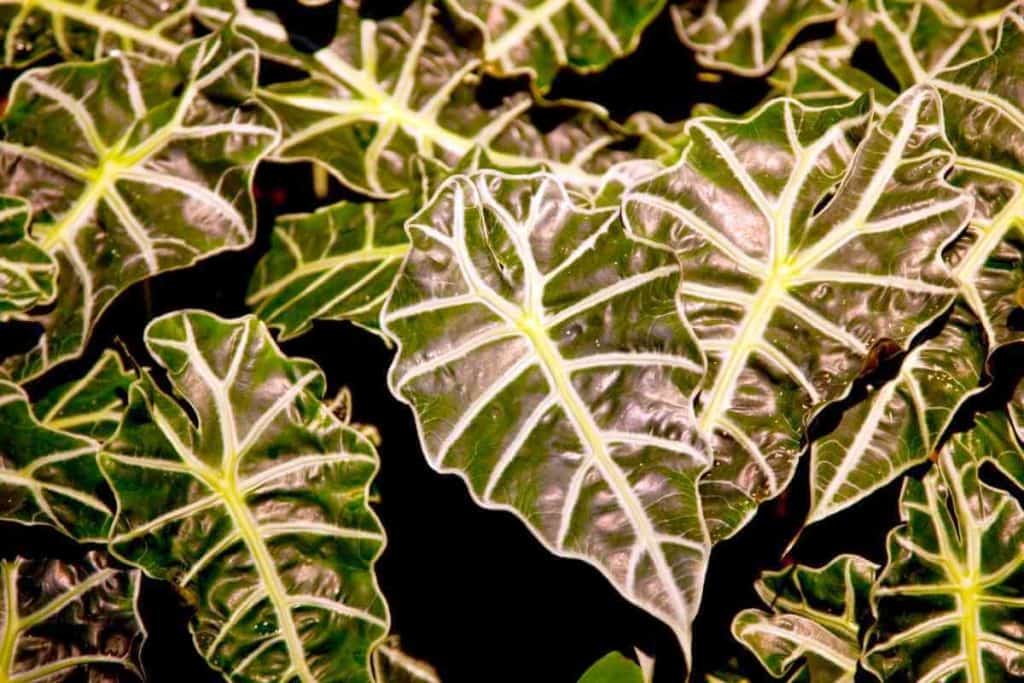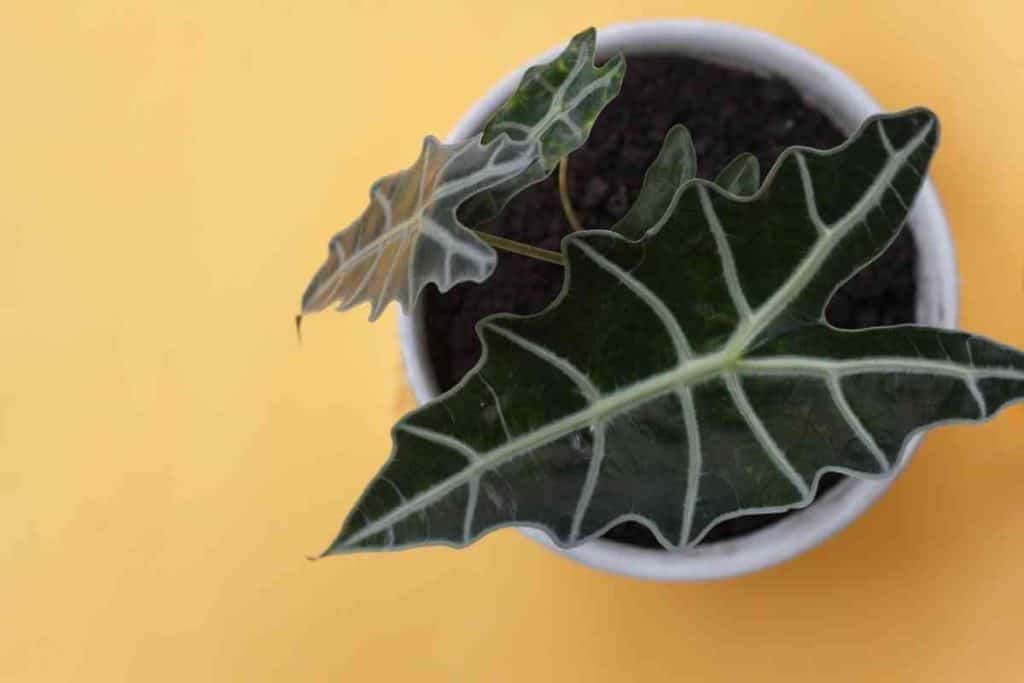Are you searching for an amazing plant that is truly eye-catching? Think no further than the genus Alocasia Polly.
It is one of the most popular and attractive varieties of the genus alocasia family and is a hybrid plant that is quite tricky to care for yet is worth every dime you spend on it.
The alocasia Polly is the perfect plant for beginners as long as its care requirements are met. Just position it under bright indirect light, and where it can get temperatures within 65 to 85℉.
It thrives under high humidity and frequent watering, but make sure to water when the top 2 inches of soil is dry. Your feeding, if necessary, should be done monthly in the growing season.
Here, we will talk about how to care for alocasia Polly.
Let’s get started!
Table of Contents
What is Alocasia Polly? | Alocasia Polly Origin
| Common Name | African Mask, Elephant Ear |
| Botanical Name | Alocasia amazonica polly |
| Plant Type | Aroid, Tropical |
| Family | Alocasia genus |
| Sun Exposure | Bright, Indirect Light |
| Mature Size | Up to 24 inches tall and wide |
| Soil Type | Aroid, Well-draining, Loamy soil |
| Leaf Color | Dark Green |
| Native Area | Native to Southeast Asia & Australia |
| Temperature | Between 65ºF to 85ºF |
| Toxicity | Toxic to both humans and animals when eaten |
| Cool Hardiness | USDA Zones 3 to 11 |
Also known as African Mask and Elephant Ear, the alocasia Polly is an evergreen exotic hybrid of the alocasia genus, which has its origin in the Asian region.
It is quite an attractive plant that can grow up to just 20 inches tall and has dense foliage. It also features beautiful dark green leaves that possess showy veins and borders with shades of white to grey color.
The alocasia Polly is a very exciting prospect for indoor planting, be it in pots or containers. It can also be grown outdoors under partial shelter conditions in USDA zones 3 to 11.
The plant features significant scalloped edges and arrow-shaped tips that make them even more attractive. Its leaves shape is why it is popularly called the Elephant Ear plant and African Mask plant.
Is Alocasia Polly Easy To Care For?
Despite how attractive the alocasia Polly is, caring for it is quite trickier than most other houseplants. However, it doesn’t, in any way, stop you from adding it to your attractive collections.
All that is required of you is to know the basic care tips, especially regarding lighting, water, fertilizing, and soil requirements, and you’re good to go.
How to Care For Alocasia Polly

Natural Habitat & Light Requirements
Alocasia Polly is a cultivar that is formed from its parent plant, Alocasia amazonica, which is why it is much smaller than the latter.
The alocasia Polly was created by crossing two different alocasia hybrids, namely alocasia watsoniana/longiloba and alocasia sanderiana. It was formed during the mid-1950s by Salvadore Mauro, a greenhouse grower.
To cut the long story short, technically, there’s no natural habitat for the alocasia Polly and never originated in the Amazon or its environs.
However, you can still tell where it came from via its grandparent’s origin, the tropical forests in Southern China and Southern East Asia, and the tropical areas of the Philippines.
In its natural habitat, the alocasia Polly does not like direct sun, as taller trees act as shade to protect the plant from the sun's direct heat.
But it also needs light; filtered sunlight will do. Indoors, you can place it close to a windowsill spot with more light, but not to be exposed to the excessive harsh sun.
Watering Requirements
Watering is often the trickiest and most challenging aspect of the alocasia Polly care. In other words, you need to be very careful with its watering, given its origin in the tropical areas of South East Asia and Australia, where they survive under dry climates.
In other words, it doesn’t require excessive watering. Like most other alocasia varieties, watering of the Polly should be done weekly, when the top inches of the soil are dry and with frequent misting, to keep the soil moist rather than wet.
Just like it doesn’t like to be overwatered, it also hates to be underwatered for long periods, as it’ll turn its leaf edges to brown.
Humidity & Temperature
The ideal temperature for the alocasia Polly should be within 64 to 79°F (18 to 26°C). It can also survive at room temperature. Avoid very cold temperatures because they can make the plant suffer dormancy. Again, any temperature below 50°F (10°C) is risky and a threat to the plant’s life.
Humidity-wise, given its origin in the sub-tropical climates, the alocasia Polly thrives under high humidity of 60% and above. You can create this humidity level yourself by placing the plant on a tray of water filled with pebbles.
Alternatively, you can use a humidifier during the winter when the indoor air becomes too dry with radiator and heating systems.
Soil Requirements
The best soil for the alocasia Polly is a kind of soil that can retain the right amount of water and at the same time drain out excess water completely.
As such, loamy soil mixed with perlite is a perfect choice. Perlite is added to enhance more air space in the soil to help the roots grow easily.
The alocasia Polly doesn’t depend so much on the soil to give it moisture because it retains some in its stems. So, you should look for soil with a well-draining ability. Also, ensure the soil does not hold water for too long to prevent root rot, as it could no longer absorb moisture.
Fertilizing Needs
As we earlier mentioned, alocasia Polly does not require too much fertilizing, although you can fertilize sparingly using a liquid fertilizer meant for houseplants. Again, the feeding should be done monthly in the growing season during the spring and summer periods.
You can dilute the fertilizer to half strength, as it will help to reduce the excessive nutrients for your plants (overloaded nutrient on plants, meanwhile can be disastrous to the plant.
Therefore, we recommend that you try out some organic products if necessary, as they will yield good results.
Planting (Potting & Repotting)
The ideal time to repot your alocasia Polly is once in a year or two years because, just like most other houseplants, at this time, it must have grown beyond its pot, which, in turn, makes it to be root bound.
Therefore, when repotting, find a pot that is large enough to house the plant’s root system so that it’ll have enough room to express itself.
How to Prune Alocasia Polly
There are one of two reasons why many plants require pruning. It’s either you are pruning them to stop them from becoming too long, huge, or unruly, or you are doing so to keep them healthy.
But as long as the alocasia Polly is concerned, it is pruned just for aesthetic sake. It is necessary to cut off dead or dying leaves to stop the plant from wasting resources. You can prune by trimming the leaf stem at the root of the plant.
Alocasia Polly Propagation

There are several ways of propagating the alocasia Polly, including the stem cutting and division method.
But, since it is a plant that grows from a central corm, the best method is propagation by division, as it will help to multiply your plant. Fortunately, alocasia Polly will not stress you much, as it does most of the work.
In other words, it grows in a clumping way that makes you easily separate them. The following steps are required if you must propagate your alocasia Polly through the division method;
- Remove the plant from its pot and reduce the excess soil. Place it on a trash bag so you can see for yourself what you’re handling. Sometimes, different parts will have separated already at this stage.
- If you find any clumps still glued to each other, you can easily cut them vertically using a clean knife to set them apart and make sure the root system is still intact on each of them.
- In a case where you find a clump lacking a root system, just put their roots in water or moist sphagnum peat moss.
- You can pot any rooted clump in normal aroid soil. Sprinkle them some water. Even though they’ll initially sulk, they’ll certainly grow as they should with time.
Alocasia Polly Varieties
Apart from the alocasia Polly, we have some other varieties that are also almost similar that you could even confuse for being Polly in itself. These varieties also feature some of the amazing qualities of the alocasia Polly and belong to the genus alocasia hybrids. They include;
- Original Alocasia Amazonica: this variety is the offspring of the sanderiana and watsoniana breeds. It has huge and attractive showy green foliage.
- Alocasia Amazonica ‘Polly’: this variety is an offspring of the Amazonica hybrid, which features medium to huge, showy, and attractive green foliage.
- Alocasia amazonica ‘Ivory Coast’: it is an offspring of the amazonica variety and features arrow-shaped leaves that do not have wavy edges.
- Alocasia amazonica ‘Bambino Arrow’: an offspring of the Polly species. Certainly a smaller version of the alocasia Polly, featuring thinner and matte foliage.
- Alocasia ‘Mandalay’: it is an offshoot of the alocasia Polly, featuring more rounded leaves with more vivid veins.
Frequently Asked Questions
How Do I Keep My Alocasia Polly Leaves Attractive?
You can simply keep the leaves of your alocasia Polly attractive and shiny by cleaning them. Cleaning the leaves also helps get rid of dust and wipe off pests such as spider mites. You can clean the leaves easily by using a soft, wet cloth to gently wipe down the top and underneath your plant’s leaves.
Can I Grow Alocasia Polly in Water?
Yes. You can grow your alocasia Polly species in water by removing every soil from its roots before you transplant it in water, as it’ll help to keep diseases away.
How Fast Does Alocasia Polly Grow?
Alocasia Polly species is certainly a rapid-growing variety. It can produce one to two fresh leaves in a month. However, its smaller varieties may start a bit slower.
Should I Mist My Alocasia Polly?
Since alocasia Polly is a lover of humidity, it will certainly thrive if you mist regularly. But, just be watchful of the symptoms of potential fungal and diseases threats.
Does Alocasia Polly Die During the Winter Season?
Of course not. However, the alocasia Polly goes through a period of dormancy, when some aged leaves will probably die off. But, there’s nothing to worry about when it happens, as it gives the plant a period of rest after much stress during the growing season.
Why is My Alocasia Polly Dripping Water?
When a plant drips water, it is called Guttation. It is a process that allows the plant to release excess water, which it doesn’t require. And it often shows that you should minimize your watering activities on your plant, including the alocasia Polly.
Is Alocasia Polly Toxic to Cats & Dogs?
Yes, the alocasia Polly is toxic to cats and dogs because it has calcium oxalate crystals content that can result in a burning sensation whenever you come in contact with it, especially when consumed. Therefore, make sure it is out of the reach of your kids and pets.




